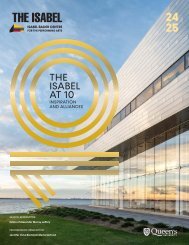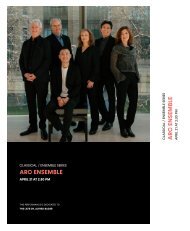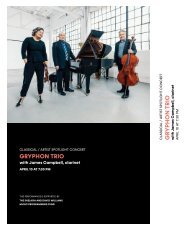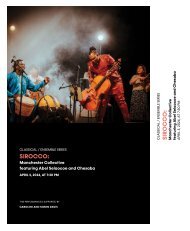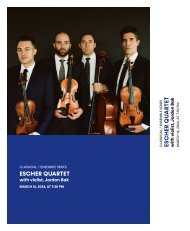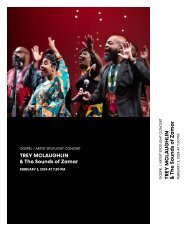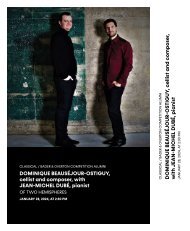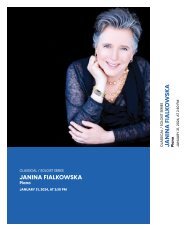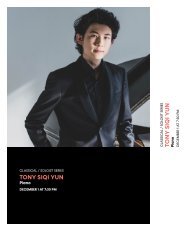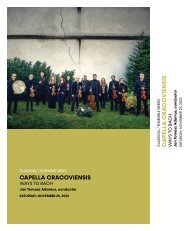Camilla Tilling and Emanuel Ax | October 31, 2023 | House Program
- No tags were found...
Create successful ePaper yourself
Turn your PDF publications into a flip-book with our unique Google optimized e-Paper software.
PROGRAM NOTES<br />
The thread running through this concert is<br />
the 19th-century singer, Jenny Lind (1820-<br />
1887), affectionately known as the “Swedish<br />
Nightingale.” Swedish soprano <strong>Camilla</strong> <strong>Tilling</strong> has<br />
felt a connection to Jenny Lind since receiving<br />
a scholarship named in Lind’s honour when<br />
she was 24. In 2020, <strong>Tilling</strong> curated tonight’s<br />
program to celebrate the 200th anniversary of<br />
Lind’s birth, by focussing specifically on Lind’s<br />
passion for German Lieder. As <strong>Tilling</strong> writes, “…<br />
the composers on this program not only featured<br />
on Jenny’s famed US tour that was promoted<br />
by the showman, P.T. Barnum, but were also<br />
linked to Jenny through musical collaboration<br />
<strong>and</strong> friendship. Indeed, the Schumanns were<br />
such dear friends–Jenny regularly performed<br />
works by Robert—<strong>and</strong> she would on occasion<br />
join Clara Schumann (a most celebrated concert<br />
pianist <strong>and</strong> tourer at this time) on stage to bolster<br />
audience numbers at Clara’s concerts. Through<br />
the Schumanns, Jenny was introduced to both<br />
Chopin–it is rumoured she even gifted him a<br />
large sum to help him in his final years—<strong>and</strong><br />
Mendelssohn with whom Jenny had a supposedly<br />
turbulent romantic entanglement.”<br />
Mendelssohn’s Opus 8, No. 8, “Witches’ Song,”<br />
uses fiery piano octaves <strong>and</strong> a demonic energy to<br />
convey Beelzebub <strong>and</strong> his witches <strong>and</strong> certainly<br />
seems highly appropriate for this concert taking<br />
place on Halloween. The next three Opus 86<br />
Lieder are taken from a six-song collection that<br />
was assembled posthumously, noting that all of<br />
the songs in this collection have a more singular<br />
focus on love poetry than the variety of songs<br />
that the composer himself usually assembled<br />
for publication: “The Beloved Writes” (No. 3), is<br />
a desperate love letter to someone who has yet<br />
to return their advances; “Nightly in My Dreams”<br />
(No. 4), describes an unsatisfied relationship<br />
where the love’s vision is only present in dreams;<br />
<strong>and</strong> “The Moon” (No. 6), personifies the love<br />
interest as the moon, with pleas to have it<br />
lighten the night. Of the concluding set of<br />
four Mendelssohn songs, the last one, “On<br />
Wings of Song,” is one of the composer’s<br />
most recognizable melodies. It might also<br />
be familiar to listeners from the 1954 version<br />
that Doris Day recorded under the title,<br />
“Til My Love Comes to Me.”<br />
French mezzo-soprano Pauline Viardot, born a<br />
year later than Jenny Lind, also had an illustrious<br />
career. She counted amongst her friends, Chopin,<br />
who in addition to advising her on piano playing<br />
<strong>and</strong> composing, gave her approval to rework<br />
some of his solo piano mazurkas into songs. The<br />
piano part in these arrangements generally stays<br />
true to Chopin’s originals but, as you will hear in<br />
Opus 33, No. 2, Viardot’s flirtatious text <strong>and</strong> vocal<br />
delivery, take this Polish dance to another level.<br />
Schumann’s Opus 98A adds music to a total<br />
of nine songs sung by different characters in<br />
Goethe’s eight-part novel, Wilhelm Meister,<br />
noting that Opus 98B also uses the same source<br />
material in a cantata-type work titled, Requiem<br />
for Mignon. The two Opus 79 songs are exquisite<br />
miniatures from his “Song Album for the Young.”<br />
with No. 23 (“Spring is Here”) employing a<br />
piano part that generates spaces for the singer’s<br />
beautiful high notes to shine through, <strong>and</strong><br />
No. 13 (Ladybug), sets to music the German<br />
equivalent of “Ladybug, Ladybug, fly away<br />
home….” In 1840, Robert Schumann composed<br />
over 130 songs, a truly prolific year. The focus<br />
on so much romantic poetry that year can be<br />
traced to the legal battle that he <strong>and</strong> Clara had<br />
won over her father’s refusal to allow them to<br />
marry. The final four songs on this program<br />
are from this “year-of-song” with the period’s<br />
happiness heard most prominently in Op. 39,<br />
No. 12 (Spring Night), which builds repeated<br />
chordal patterns to a powerful ending as the<br />
poem highlights the many aspects of spring<br />
that are crying out, “She is yours!”<br />
All of the composers on tonight’s program were<br />
highly skilled pianists <strong>and</strong> their underst<strong>and</strong>ing of<br />
the keyboard is often used to generate textures<br />
between the two h<strong>and</strong>s that can be remarkably<br />
intricate <strong>and</strong> complex. The opportunity to hear<br />
some of the solo piano music performed in the<br />
context of a vocal recital, helps to emphasize<br />
the songlike quality of their instrumental<br />
melodic writing, as can be heard in the very<br />
operatic melodic focus of Chopin’s Nocturnes<br />
<strong>and</strong> the lyrical flowering of the coda that ends<br />
Schumann’s Arabeske.<br />
©<strong>2023</strong> by John Burge for the Isabel






